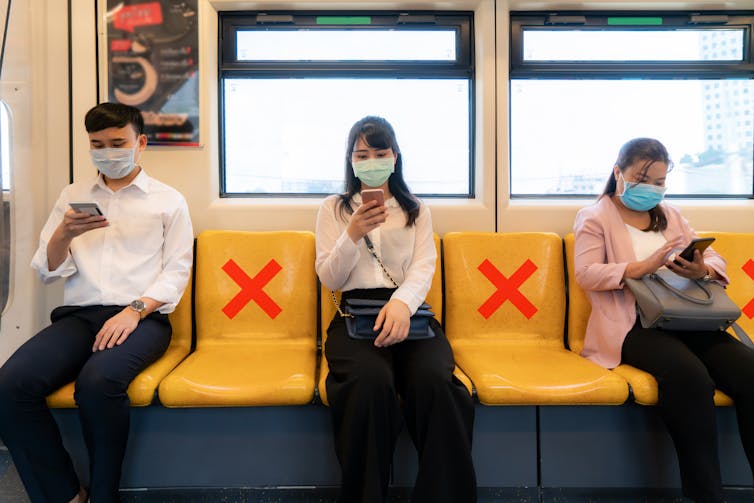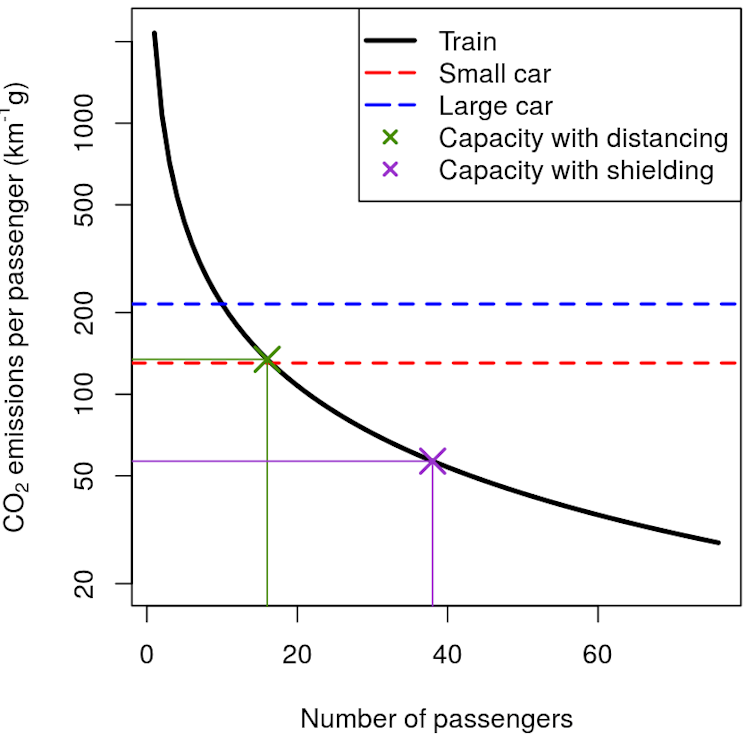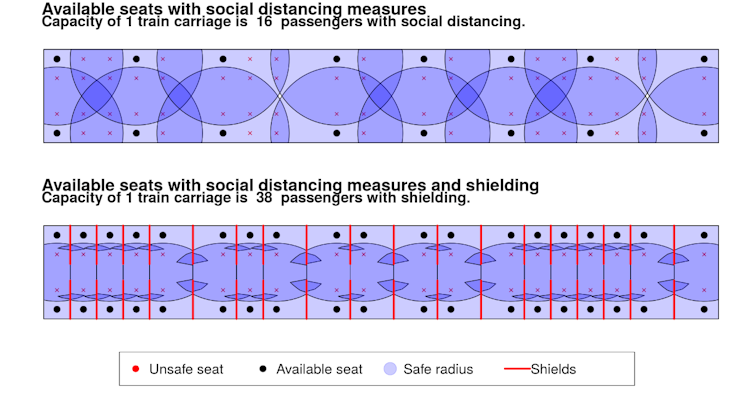Social distancing is making public transport worse for the environment than cars – here’s how to fix it
16 September 2020
Thomas Woolley, Lecturer at School of Mathematics, and Joshua Moore, Lucy Henley, and Timothy Ostler, PhD students at School of Mathematics.
During lockdown, travel restrictions caused car and public transport use to plummet across the UK. On April 12 2020, the number of daily trips by car fell to 22%, compared to a typical day the year before. Public transport use dropped too. National Rail ticket sales were at 4% of their pre-pandemic norm and bus ticket sales outside of London fell to 10%.
With one-third of the world under lockdown at one point, travel restrictions in different countries contributed to a global reduction in carbon dioxide (C0₂) emissions of 17% in April, compared to 2019. But as these measures have been relaxed, personal vehicle use has increased again, approaching 80% of typical levels by mid-July. Unfortunately, public transport use remains low, with train ticket sales and buses outside of London still running at 16% and 31% of normal, respectively.
While more people opt for travel by car and private transport, the number of passengers that trains and buses can carry has also been reduced to meet social distancing guidelines. This means that people from different households must keep one to two metres apart. So, once a seat is taken, surrounding seats must be left empty.
This has had a profound effect on the climate impact of train and car travel. When running at normal capacity, public transport is more environmentally friendly than travelling by car. Although a train or bus can produce more C0₂ than a car, they transport far more people, so emissions per person are lower overall.
But under social distancing conditions, and assuming that any unfilled seats correspond to a commuter driving to work instead, diesel-powered public transport produces more C0₂ emissions per passenger than a small car.

Keeping pandemic public transport green
So how best to pack public transport given the fixed space and social distancing guidelines? We designed an app that optimises the number, and seating arrangement, of people who can safely use public transport. The app allows a public transport company to see the optimal spacing strategy in various scenarios of social distancing and includes the option of using plastic shielding for increased isolation.
The calculation works by trying to fill in passengers from the back of the train, putting the first passenger in the first seat. The app then draws a social distancing bubble around the passenger. Other seats that are inside the bubble cannot be used, so they’re ignored and the next passenger is put in the next available seat. This process is repeated until all seats are either filled or designated as empty. This is known as a greedy algorithm – it doesn’t consider all seats at the same time, it just chooses the next available seat.
The app is currently fixed to one carriage size, and so it’s mainly useful for public transport companies making planning decisions. But it’s open-source, which means it could be extended to include different carriage designs and sizes and allow passengers to input which seats in their carriage are taken, so the app can advise which is the safest seat for them to choose.
In South Wales, the most commonly used train is the class 150 diesel engine, which was made in the 1980s. If a company using these trains can encourage at least ten passengers per carriage to use their service, then they will be more efficient than a large car. But trains using these inefficient diesel engines require a minimum of 17 passengers to be more environmentally friendly than a small car. Without the use of plastic shielding between seats though, a train carriage can only support a maximum of 16 socially distanced passengers.
Including plastic shielding in carriages can increase the maximum number of passengers in a single carriage to 38, making the emissions per passenger much lower than a small car.

Road transport makes up around 20% of the UK’s greenhouse gas emissions. Reducing this is key to the country’s strategy for meeting net zero emission targets, and public transport should play a leading role in this effort. But for that to happen, there will need to be significant changes to keep passengers safe during the pandemic while preserving the environmental benefits of bus and train travel.
Social distancing measures would either need to be reduced, while increasing other safety measures, such as mask wearing and regular cleaning, or plastic shields would need to be added between seats in train and bus carriages. Investment in lower emission engines could also help drive a transition towards more fuel-efficient public transport.
Our research should serve as a warning. As lockdown measures continue to be relaxed, more people will travel for work and leisure, increasing demand for public transport. If these services are ramped up without adding more protective measures, trains and buses could operate at a significant financial loss, while negating any benefits for the environment.
This article is republished from The Conversation under a Creative Commons license. Read the original article.
- February 2025
- September 2024
- June 2024
- March 2024
- February 2024
- November 2023
- September 2023
- June 2023
- May 2023
- January 2023
- December 2022
- November 2022
- October 2022
- September 2022
- July 2022
- May 2022
- April 2022
- January 2022
- December 2021
- November 2021
- August 2021
- July 2021
- June 2021
- February 2021
- January 2021
- November 2020
- October 2020
- September 2020
- August 2020
- July 2020
- June 2020
- April 2020
- March 2020
- February 2020
- January 2020
- December 2019
- November 2019
- October 2019
- September 2019
- August 2019
- July 2019
- June 2019
- May 2019
- April 2019
- March 2019
- February 2019
- January 2019
- December 2018
- November 2018
- October 2018
- September 2018
- August 2018
- July 2018
- June 2018
- May 2018
- April 2018
- March 2018
- February 2018
- Biosciences
- Careers
- Conferences
- Development
- Doctoral Academy Champions
- Doctoral Academy team
- Events
- Facilities
- Funding
- Humanities
- Internships
- Introduction
- Mental Health
- PGR Journeys
- Politics
- Public Engagement
- Research
- Sciences
- Social Sciences
- Staff
- STEM
- Success Stories
- Top tips
- Training
- Uncategorized
- Wellbeing
- Working from home